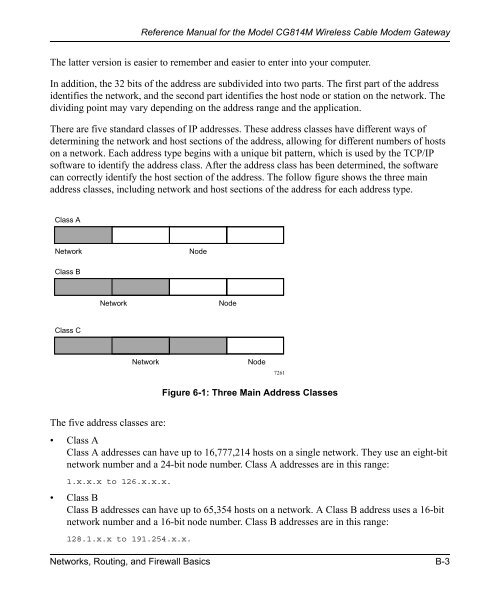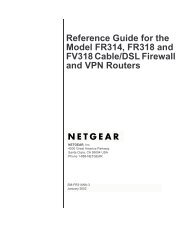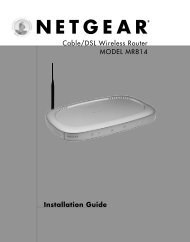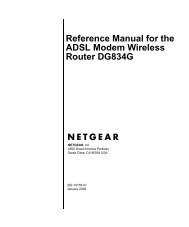Reference Manual for the Model CG814M Wireless Cable ... - netgear
Reference Manual for the Model CG814M Wireless Cable ... - netgear
Reference Manual for the Model CG814M Wireless Cable ... - netgear
You also want an ePaper? Increase the reach of your titles
YUMPU automatically turns print PDFs into web optimized ePapers that Google loves.
<strong>Reference</strong> <strong>Manual</strong> <strong>for</strong> <strong>the</strong> <strong>Model</strong> <strong>CG814M</strong> <strong>Wireless</strong> <strong>Cable</strong> Modem Gateway<br />
The latter version is easier to remember and easier to enter into your computer.<br />
In addition, <strong>the</strong> 32 bits of <strong>the</strong> address are subdivided into two parts. The first part of <strong>the</strong> address<br />
identifies <strong>the</strong> network, and <strong>the</strong> second part identifies <strong>the</strong> host node or station on <strong>the</strong> network. The<br />
dividing point may vary depending on <strong>the</strong> address range and <strong>the</strong> application.<br />
There are five standard classes of IP addresses. These address classes have different ways of<br />
determining <strong>the</strong> network and host sections of <strong>the</strong> address, allowing <strong>for</strong> different numbers of hosts<br />
on a network. Each address type begins with a unique bit pattern, which is used by <strong>the</strong> TCP/IP<br />
software to identify <strong>the</strong> address class. After <strong>the</strong> address class has been determined, <strong>the</strong> software<br />
can correctly identify <strong>the</strong> host section of <strong>the</strong> address. The follow figure shows <strong>the</strong> three main<br />
address classes, including network and host sections of <strong>the</strong> address <strong>for</strong> each address type.<br />
Class A<br />
Network Node<br />
Class B<br />
Class C<br />
Network Node<br />
The five address classes are:<br />
Figure 6-1: Three Main Address Classes<br />
• Class A<br />
Class A addresses can have up to 16,777,214 hosts on a single network. They use an eight-bit<br />
network number and a 24-bit node number. Class A addresses are in this range:<br />
1.x.x.x to 126.x.x.x.<br />
• Class B<br />
Class B addresses can have up to 65,354 hosts on a network. A Class B address uses a 16-bit<br />
network number and a 16-bit node number. Class B addresses are in this range:<br />
128.1.x.x to 191.254.x.x.<br />
Network Node<br />
Networks, Routing, and Firewall Basics B-3<br />
7261
















